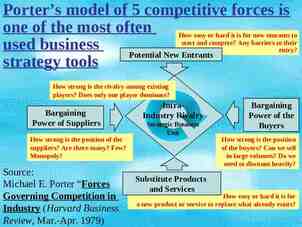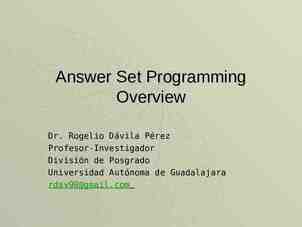Contingencies in Classical Conditioning Rescorla’s Experiment Three
17 Slides216.50 KB

Contingencies in Classical Conditioning Rescorla’s Experiment Three Phases Phase 1: Avoidance Conditioning: Establish a behavioral measure (operational definition) of “fear” (intervening variable). Phase 2: Classical Conditioning: Arrange positive, negative, and zero contingencies between tone and shock. Phase 3: Avoidance Conditioning: Present CS from Phase 2 at random times during avoidance procedure; see if fear increases, decreases, or stays the same.

Rescorla’s Experiment Phase 1: Avoidance Conditioning: Establish a behavioral measure (operational definition) of “fear” (intervening variable). Avoidance behavior is behavior that prevents the occurrence of an aversive stimulus, like shock. Some theories say it is motivated by fear: Fea r Avoidance response The avoidance behavior can serve as an operational definition of fear: stronger behavior more fear.

Rescorla’s Experiment Phase 1: Avoidance Conditioning: Establish a behavioral measure (operational definition) of “fear” (intervening variable). Apparatus: “Shuttle box” Dog jumps over barrier from one compartment to the other to avoid shock. If he stays in one compartment, he gets shocked every 10 seconds (shock-shock, S-S) interval. If he jumps before 10 seconds are up, he’s safe for 30 seconds (response-shock, R-S) interval.

Rescorla’s Experiment Phase 1: Avoidance Conditioning: Establish a behavioral measure (operational definition) of “fear” (intervening variable). Apparatus: “Shuttlebox” If he jumps before the 30 seconds are up, he gets another 30 seconds. But if he messes up and gets shocked, then the S-S interval takes over, and he gets shocked again in 10 seconds. Result: The dogs keep jumping at a steady, moderate pace, and avoid most of the shocks.

Rescorla’s Experiment Phase 1: Avoidance Conditioning: Establish a behavioral measure (operational definition) of “fear” (intervening variable). Apparatus: “Shuttlebox” The rate at which he jumps is the operational definition of fear. The faster he jumps, the more afraid he is. Fea r Jumping response

Rescorla’s Experiment Phase 2: Classical Conditioning: Arrange positive, negative, and zero contingencies between tone and shock. US shock UR CS CR pa tone fe in at random intervals, ar Tones come on averaging 30 seconds. Each lasts 5 seconds. There are three groups that get shocks in different patterns so there is a zero, positive or negative contingency between the shocks and the tones.

Rescorla’s Experiment Phase 2: Classical Conditioning: Arrange positive, negative, and zero contingencies between tone and shock. Group R (random pattern of shocks) There is a zero contingency. The probability of shock right after a tone is the same as it is before tones and between tones. A B C D Note that shocks B and D are paired with tones, but overall the tone has no predictive value.

Rescorla’s Experiment Phase 2: Classical Conditioning: Arrange positive, negative, and zero contingencies between tone and shock. Group P (positive contingency) Same as Group R except that only shocks that come right after tones get through; there are no shocks before or between tones. A B C D Note that Groups P and R get the same number of pairings, important to Pavlov but not Rescorla.

Rescorla’s Experiment Phase 2: Classical Conditioning: Arrange positive, negative, and zero contingencies between tone and shock. Group N (negative contingency) Same as Group R except that NO shocks due to come right after tones get through, only the shocks before and between tones. A B C There are no CS-US pairings in Group N. D

Analyzing Contingencies in Phase 2 This chart summarizes conditions for Groups R, P and N in terms of conditional probabilities. Group P (US CS) P Above 0 N R 0 P (US no CS) 0 Above 0 Equal values Rescorla predicts. Fear CR Relaxation CR No CR

Analyzing Contingencies in Phase 2 This chart summarizes conditions for Groups R, P and N in terms of conditional probabilities. Group P (US CS) P Above 0 N R 0 P (US no CS) 0 Above 0 Equal values PAVLOV predicts. Fear ? CR No?CR Fear ? CR

Rescorla’s Experiment Phase 3: Avoidance Conditioning: Present CS from Phase 2 at random times during avoidance procedure; see if fear increases, decreases, or stays the same. The contingencies from Phase 2 are discontinued. When the tone comes on, it stays on for 5 seconds, then goes off. It has nothing to do with the avoidance procedure; it’s just something added on top of it. The dog gets shocked only if he waits too long to jump, as required by the avoidance procedure.

Rescorla’s Experiment Phase 3: Avoidance Conditioning: Present CS from Phase 2 at random times during avoidance procedure; see if fear increases, decreases, or stays the same. The question is: When the tone comes on, does the dog jump faster, slower, or at the same rate as before the tone? Rate of jumping is the operational definition of fear. Therefore, we can make the following inferences:

Rescorla’s Experiment Phase 3: Avoidance Conditioning: Present CS from Phase 2 at random times during avoidance procedure; see if fear increases, decreases, or stays the same. Jump rate means the tone produced an increase in overall fear. Jump rate means the tone produced a decrease in overall fear. If the rate of jumping doesn’t change, it means there was no CR to the tone.

Rescorla’s Experiment Phase 3: Avoidance Conditioning: Present CS from Phase 2 at random times during avoidance procedure; see if fear increases, decreases, or stays the same. ? If the tone has nothing to do with the shocks, how can it increase the animal’s level of fear? Avoidanc e procedure CS CR (fear) adds to the fear from the avoidance procedure. Fear CR (fear) Total Fear Jump It’s total fear that controls jumping.

Rescorla’s Experiment Phase 3: Avoidance Conditioning: Present CS from Phase 2 at random times during avoidance procedure; see if fear increases, decreases, or stays the same. How can the tone decrease the animal’s fear? Suppose the tone produces a conditioned response of inhibition instead of fear. This inhibition suppresses some of the fear produced by the avoidance procedure. Another term for this inhibition is “relaxation”. Avoidanc e fear - Relaxatio Less total fear n response Less total fear means less jumping.

Scorecard: Pavlov Versus Rescorla Here are the results. Who made the right predictions? Group Rate of jumping. P INCREASED N DECREASED X R NO CHANGE X Pavlov Rescorla






